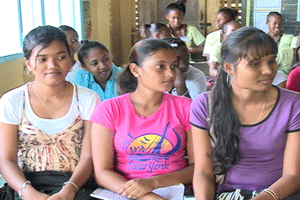Youth violence prevention explored
THE issue of youth violence is universal in nature, poses serious threats to many societies, and is often overlooked or not dealt with adequately.  The World Health Organisation defines violence as the use of physical force or power, threatened or actual, against oneself, another person, or against a group or community, which either results in, or has a high likelihood of resulting in, in injury, death, psychological harm, mal-in development or deprivation.
The World Health Organisation defines violence as the use of physical force or power, threatened or actual, against oneself, another person, or against a group or community, which either results in, or has a high likelihood of resulting in, in injury, death, psychological harm, mal-in development or deprivation.
From this the many implications can be determined, along with the high priority needed to address it. In many countries, violence prevention is still a new and emerging field.
In a focused way, Guyana has embarked on this approach. Through its Citizen Security Programme/Community Action Component, the Inter American Development Bank, in partnership with the Ministry of Home Affairs, has embarked on a comprehensive approach to violence prevention in ten selected communities in Regions 4 and 6.
Previous columns would have detailed various aspects of this intervention, which targets youths. The strategy is based on the fact that young people are critical in the process.
As in many societies, the forms of violence identified bear some serious linkages with this group of citizens. Studies have shown that victims of child abuse have an above-average chance of being involved in aggressive and violent behaviours as adolescents and adults, and sexual abuse during childhood or adolescence has been linked to suicidal and other forms of anti-social behaviour.
Many law enforcement experts agree that violence must be met with solutions from disciplines other than law enforcement. They acknowledge that social conditions such as family stability, education, and other societal institutions directly affect the behaviour of juveniles, and thereby affect the safety of communities. Risk factors also include the prevalence of drugs, absence of social networks, and poverty.
The target communities under the CSP/CAC bear traits of those described above. The interventions under the programme are not aimed at only creating opportunities through skills training, but provide for highly interactive sessions on various forms of violence prevention, on child abuse and intimate partner and domestic situations. In these communities, hundreds of young people are participating in the violence prevention sessions.
Violence cannot be attributed to a single factor. Among the key levels of causes, there is the focus on close relationships, such as family and friends. In youth violence, for example, having friends who engage in or encourage violence can increase a young person’s risk of being a victim or perpetrator of violence. For intimate partner violence, the most consistent marker is marital conflict or discord in the relationship. Childhood exposure to violence is also very damaging.
As Guyana embarks on this violence prevention approach, it recognises the value of cultivating healthy lifestyles. Much research has shown that the health and social consequences of violence are far broader than death and injuries. Victims of violence are at risk of psychological and behavioural problems, including depression, alcohol and drug abuse, anxiety and suicidal behaviours; and there are issues such as sexually transmitted diseases, unwanted pregnancies and sexual dysfunction.
This clearly is a cost that no country wants to bear.
CSP weekly…
SHARE THIS ARTICLE :
Facebook
Twitter
WhatsApp



.jpg)











